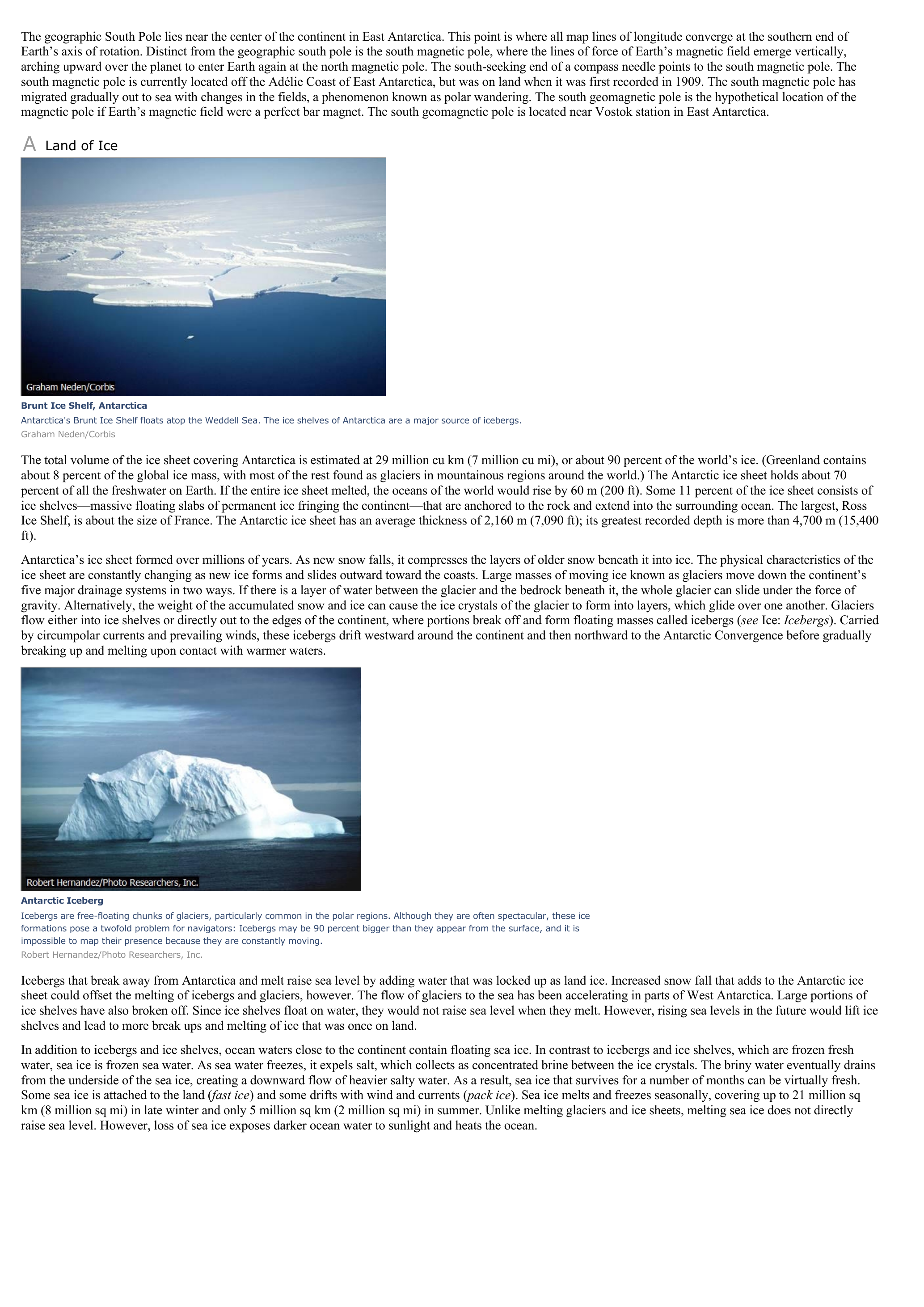Antarctica - geography.
Publié le 26/05/2013

Extrait du document
«
The geographic South Pole lies near the center of the continent in East Antarctica.
This point is where all map lines of longitude converge at the southern end ofEarth’s axis of rotation.
Distinct from the geographic south pole is the south magnetic pole, where the lines of force of Earth’s magnetic field emerge vertically,arching upward over the planet to enter Earth again at the north magnetic pole.
The south-seeking end of a compass needle points to the south magnetic pole.
Thesouth magnetic pole is currently located off the Adélie Coast of East Antarctica, but was on land when it was first recorded in 1909.
The south magnetic pole hasmigrated gradually out to sea with changes in the fields, a phenomenon known as polar wandering.
The south geomagnetic pole is the hypothetical location of themagnetic pole if Earth’s magnetic field were a perfect bar magnet.
The south geomagnetic pole is located near Vostok station in East Antarctica.
A Land of Ice
Brunt Ice Shelf, AntarcticaAntarctica's Brunt Ice Shelf floats atop the Weddell Sea.
The ice shelves of Antarctica are a major source of icebergs.Graham Neden/Corbis
The total volume of the ice sheet covering Antarctica is estimated at 29 million cu km (7 million cu mi), or about 90 percent of the world’s ice.
(Greenland containsabout 8 percent of the global ice mass, with most of the rest found as glaciers in mountainous regions around the world.) The Antarctic ice sheet holds about 70percent of all the freshwater on Earth.
If the entire ice sheet melted, the oceans of the world would rise by 60 m (200 ft).
Some 11 percent of the ice sheet consists ofice shelves—massive floating slabs of permanent ice fringing the continent—that are anchored to the rock and extend into the surrounding ocean.
The largest, RossIce Shelf, is about the size of France.
The Antarctic ice sheet has an average thickness of 2,160 m (7,090 ft); its greatest recorded depth is more than 4,700 m (15,400ft).
Antarctica’s ice sheet formed over millions of years.
As new snow falls, it compresses the layers of older snow beneath it into ice.
The physical characteristics of theice sheet are constantly changing as new ice forms and slides outward toward the coasts.
Large masses of moving ice known as glaciers move down the continent’sfive major drainage systems in two ways.
If there is a layer of water between the glacier and the bedrock beneath it, the whole glacier can slide under the force ofgravity.
Alternatively, the weight of the accumulated snow and ice can cause the ice crystals of the glacier to form into layers, which glide over one another.
Glaciersflow either into ice shelves or directly out to the edges of the continent, where portions break off and form floating masses called icebergs ( see Ice: Icebergs ).
Carried by circumpolar currents and prevailing winds, these icebergs drift westward around the continent and then northward to the Antarctic Convergence before graduallybreaking up and melting upon contact with warmer waters.
Antarctic IcebergIcebergs are free-floating chunks of glaciers, particularly common in the polar regions.
Although they are often spectacular, these iceformations pose a twofold problem for navigators: Icebergs may be 90 percent bigger than they appear from the surface, and it isimpossible to map their presence because they are constantly moving.Robert Hernandez/Photo Researchers, Inc.
Icebergs that break away from Antarctica and melt raise sea level by adding water that was locked up as land ice.
Increased snow fall that adds to the Antarctic icesheet could offset the melting of icebergs and glaciers, however.
The flow of glaciers to the sea has been accelerating in parts of West Antarctica.
Large portions ofice shelves have also broken off.
Since ice shelves float on water, they would not raise sea level when they melt.
However, rising sea levels in the future would lift iceshelves and lead to more break ups and melting of ice that was once on land.
In addition to icebergs and ice shelves, ocean waters close to the continent contain floating sea ice.
In contrast to icebergs and ice shelves, which are frozen freshwater, sea ice is frozen sea water.
As sea water freezes, it expels salt, which collects as concentrated brine between the ice crystals.
The briny water eventually drainsfrom the underside of the sea ice, creating a downward flow of heavier salty water.
As a result, sea ice that survives for a number of months can be virtually fresh.Some sea ice is attached to the land ( fast ice ) and some drifts with wind and currents ( pack ice ).
Sea ice melts and freezes seasonally, covering up to 21 million sq km (8 million sq mi) in late winter and only 5 million sq km (2 million sq mi) in summer.
Unlike melting glaciers and ice sheets, melting sea ice does not directlyraise sea level.
However, loss of sea ice exposes darker ocean water to sunlight and heats the ocean..
»
↓↓↓ APERÇU DU DOCUMENT ↓↓↓
Liens utiles
- Antarctica - Geography.
- Otter Otters are water-loving animals found everywhere except Australia, New Zealand, and Antarctica.
- Tokyo - geography.
- Toronto - geography.
- Venice (Italy) - geography.

































